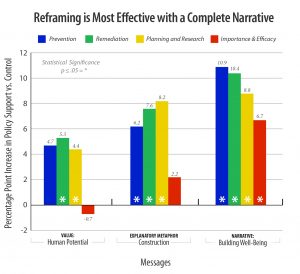Pressing the Refresh Button on Reframing
September 29, 2016The human service sector plays an integral role in creating a vibrant, thriving society. Yet each year we find ourselves having to make the case, all over again, for critical funding and better policies, while competing for limited and insufficient resources, attention, and investment. The power of reframing is that it helps us tell our story in a way that we know will build public understanding and support that is sustainable and constant over time. We are seeking no less than a cultural shift in the conversation around what it takes to make sure everyone can reach their full potential and contribute in their community.
Throughout this first year of the mobilization, we’ve shared guidance and resources to help the sector reframe our communications. This week, we want to offer a quick refresher on some of the key storytelling components involved in reframing.
The new frame is anchored by the research-based Building Well-Being Narrative, which uses the following elements together to provide the public with a complete picture of what human services are and who they benefit:
- The Value of Human Potential to orient the public to why human services matter to society;
- Construction Metaphors to provide a general explanation of how human services build well-being, as well as what can impede well-being; and
- Life Cycle Examples to provide specific examples of the benefits of humans services across the lifespan.

Image used courtesy of the FrameWorks Institute
As the chart above shows, it is imperative to use all of the narrative elements together to realize the full effect of the frame. But reframing doesn’t end with using the language of the narrative. When reframing your communications, remember that the full context of the message matters as much as the specific words used. We bolster the public’s receptivity to human services by using a reasonable tone in our communications, focusing on solutions, telling thematic stories rather than providing vivid examples, and avoiding common communications traps for our sector.

